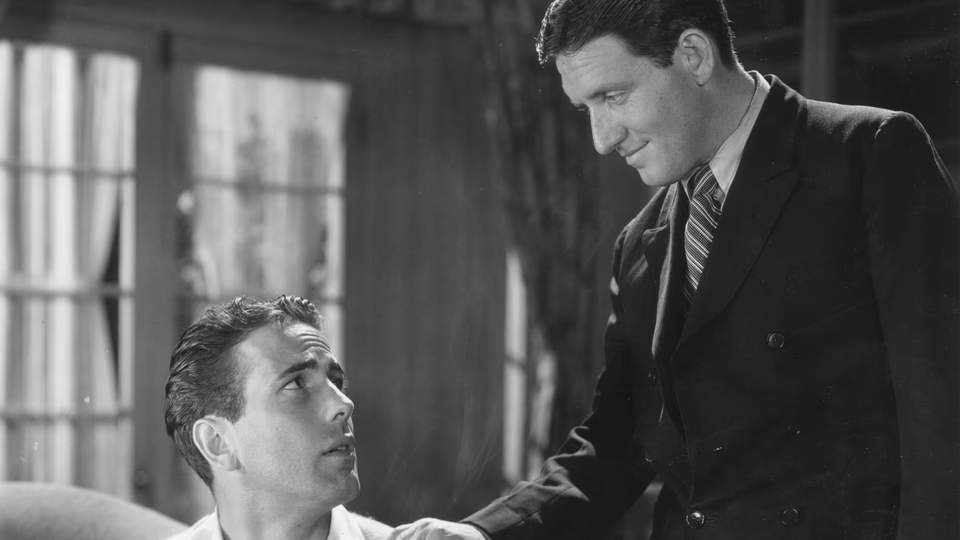Up the River

The debut feature for both Spencer Tracy and Humphrey Bogart. A lighthearted comedy that sees Tracy as the beloved ace pitcher for a prison baseball team. Tracy befriends another convict played by Bogart who’s nearing parole. Bogart’s sweet on an inmate in the neighboring woman‘s prison. Once Bogart’s released, her former partner, a scam artist, gets wind of the romance and blackmails Bogart. Just before the big game against a rival prison, Tracy escapes to help Bogart.
The sound era created a demand for stars capable of delivering dialogue and Hollywood turned to stage actors to fill the gap. Many struggled with the more intimate medium, uncomfortable with the camera or unable to modulate their delivery. Hence, many films of this era feel stagy.
In contrast to these stiff, theatrical performances, Tracy’s turn overflows with energy and effortless charm. Consider the scene where he’s brought before the warden following a failed escape. Tracy, leaning in to sit on the warden’s desk, says:
Say, listen warden, I wanna make a little bargain with you. You know, I thought you looked a little bit worried out there in the yard. You know… thinking I might leave here a little bit unexpectedly? Now I wanna tell you something warden—now I’m on the square with this—I shoot straight, see…when I decide to go, I’ll warn you. How’s that?
Director John Ford helps. Rather than stand and deliver lines, Ford has Tracy in constant motion—leaning over furniture, tossing a baseball, fidgeting with the warden’s cigar case, playing with a knife—anything to keep him moving. This perpetual action distracts from the static camera work necessitated by the early sound-proofing technology, which rendered the cameras silent but immobile.
Ford was also key in shaping the film as a comedy. Said Ford:
Bill Collier, who was a great character comedian, and I rewrote the script. There was so much opportunity for humor in it that eventually it turned out to be a comedy—all about what went on inside a prison; we had them playing baseball against Sing-Sing, and these two fellows broke back in so they’d be in time for the big game. We did it in two weeks; it was Tracy’s and Bogart’s first picture—they were great—just went right in, natural.1
Bogart, then a working Broadway actor, got his part thanks to a family connection. His brother-in-law, Stuart Rose, was the eastern story editor for the Fox Film Corporation. Rose was friendly with Fox’s New York casting director, who was searching for “actors who could talk”, and suggested Bogart. Bogart tested well, and soon found himself heading to Los Angeles to star in The Man Who Came Back. The studio recast the part before he even arrived. Instead, he split time between A Devil with Women and this film.2
Bogart’s performance pales next to Tracy’s dynamo, but he acquits himself well. As a new film actor, he didn’t have to unlearn silent-era tropes, and he avoids the over-emoting common amongst stage actors playing to the back rows. He’s not the tough guy of his later, more famous roles, but he’s no pushover either. He’s a good guy who got a raw deal.
Tracy recognizes it. An early prison yard scene sees Bogart stand up for another inmate to bully Ward Bond. Bogart orders Bond to let the other man alone, and the burly Bond turns on Bogart, towering over him. Bogart stands his ground. Not because he’s tough, but because he’s indignant at Bond’s bullying. We appreciate his outrage in the face of certain physical peril. Enter Tracy, who clocks Bond and knocks him cold. The single scene cements Bogart and Tracy’s bond and illustrates how Tracy views Bogart as a moral compass for his boundless energy. It also demonstrates another instance of Ford using in-frame action to mask the static camera
The iTunes print is spliced from multiple sources, replete with sound and frame drops, and numerous scratches. Sadly, it’s the best quality available, but it distracts from any early editing innovations Ford might be employing. Still, for Spencer Tracy fans, it’s worth seeking out, as it marks an impressive debut and stands as one of the best early talkies I’ve seen. For Bogart fans, this proves more curiosity than revelation, and they may opt to wait and hope a better print surfaces.